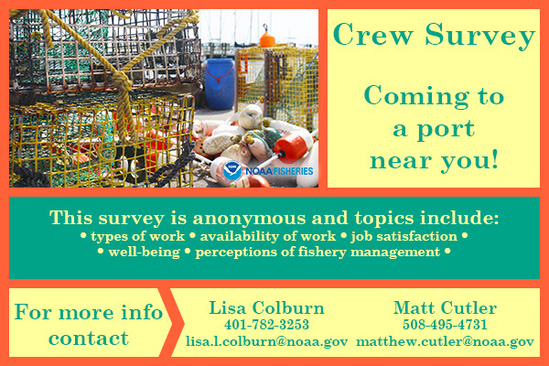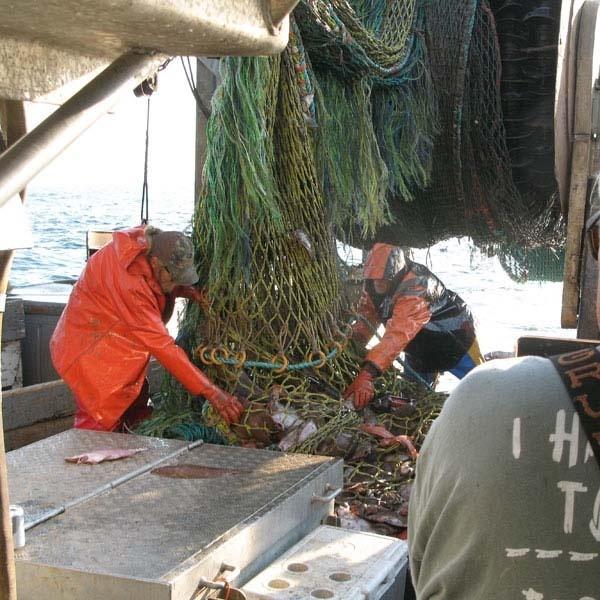Survey of hired captains and crew
Socio-Economic Survey of Hired Captains and Crew in New England, Mid-Atlantic, South Atlantic, and Gulf of Mexico Commercial Fisheries
0648-0636_Hired Captains and Crew Survey_New Release_ 060621
Survey of hired captains and crew
OMB: 0648-0636
Social Scientists Rev Up for 2019 Crew Survey
A team of researchers from NOAA’s Northeast and Southeast Fisheries Science Centers are coming to a port near you! The team is visiting fishing ports in across the East Coast and Gulf of Mexico to collect information that can help improve our understanding of how fishery actions and conditions affect the lives of fishermen, their families, and communities.
A team of researchers affiliated with NOAA’s Northeast and Southeast Fisheries Science Centers will be visiting fishing ports all along the East Coast and Gulf of Mexico to talk face-to-face with the workers so crucial to commercial fishing operations: crew and hired captains.
The researchers will be visiting ports in these regions throughout the year, collecting a range of information that can help improve understanding of how fishery actions and conditions affect the lives of fishermen, their families, and communities.
This is the third time this crew survey has been conducted. The first two surveys interviewed crew and hired captains working in the Northeast region, and covering 10 states from Virginia to Maine. This third survey will now also include 8 states in the South Atlantic region and Gulf of Mexico.
“I want to take this chance to thank all who have already participated in this survey and those who will take it this year. Your willingness to share greatly expands our knowledge and understanding of social and economic issues that matter to the lives of those who work on our waterfronts,” said Lisa Colburn, a social scientist at the Northeast Fisheries Science Center who is one of the leaders of the project.
Crew are among the least documented workers in commercial fishing operations, and there is no ready list or database of crew members from which to work. To find out more, Colburn and a team from the Northeast and Southeast Fisheries Science Center designed a relatively simple survey. Interviewers will collect responses to survey questions in person from willing crew members. Paper copies of the survey will also be available, to fill out and mail in when convenient.

Surveyors are interviewing hired captains and crew all along the East Coast and Gulf of Mexico this year.
What Researchers Want to Know
“To help fishery managers understand how regulatory actions affect people in the fishing business, we need data,” said Colburn. “We are also trying to ensure that we hear all voices. There’s just not enough data now on crew, including hired captains.”
Colburn stressed that no information is collected that would identify an individual taking the survey. “We are not collecting names or contact information or names of employers or vessels – really, nothing that would allow an individual to be identified.”
Instead, the survey focuses on topics such as recent work, typical fishing activity in a year, availability of work, types of work, fishing income, perceptions of fishery management and ability to participate in those decisions, job satisfaction, and well-being. It also gathers demographic information.
Shorter, More Effective Survey Used
This effort is one piece of a larger effort by the Science Centers to gather information about people who rely on commercial fishing for a livelihood, and the third effort that focuses on crew, including hired captains. The first was in 2012 -2013 and the second was in 2018-2019.
The team will be implementing a survey that is very similar to the one conducted in in 2018-2019. The questionnaire for that effort was revised based on lessons learned from the first survey. It’s shorter, with fewer questions, and takes about 20 minutes to complete, compared with 30 minutes or more required to complete the first survey.
The number of ports that will be visited is much larger than before with the expansion of the survey to the South Atlantic and the Gulf. The survey effort at each port is proportional to the social and economic importance of fishing and takes into account the tremendous diversity across this large area. That means the team needs to collect data in different seasons and from crew that work in different fisheries, on vessels that vary in length and in gear type. The goal is to get about 749 responses across major ports and fisheries.
Finding Crew to Survey
Typically, there would be some kind of contact list to start from when planning a survey. Lacking that, interviewers try to time their efforts to be in places where crew are most likely to be available and not busy working. It isn’t easy to get that timing right, and sometimes people are just reluctant to participate.
“The best method we have found,” said Colburn, “is to go where crew are likely to be and do all we can to get information out ahead of time about what we are doing, why we are doing it, and how vital this information is to building a more complete picture of what is actually happening among fishing people and their communities.”
More Information
See the Survey
2018-2019 Survey Results
| File Type | application/vnd.openxmlformats-officedocument.wordprocessingml.document |
| Author | Matthew.McPherson |
| File Modified | 0000-00-00 |
| File Created | 2021-07-20 |
© 2025 OMB.report | Privacy Policy
